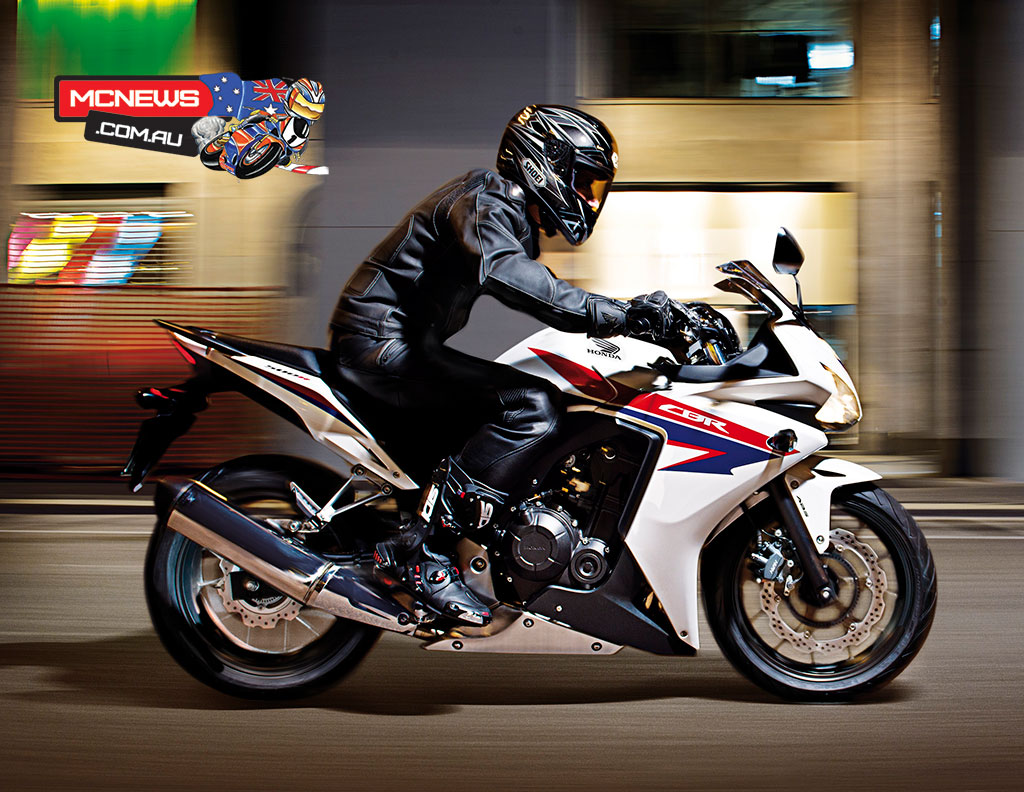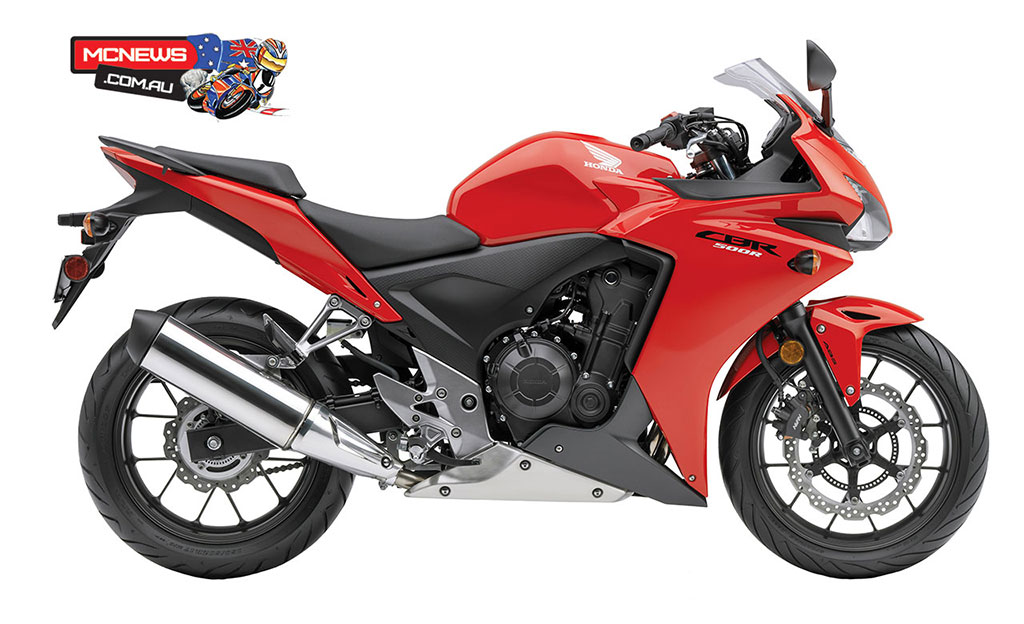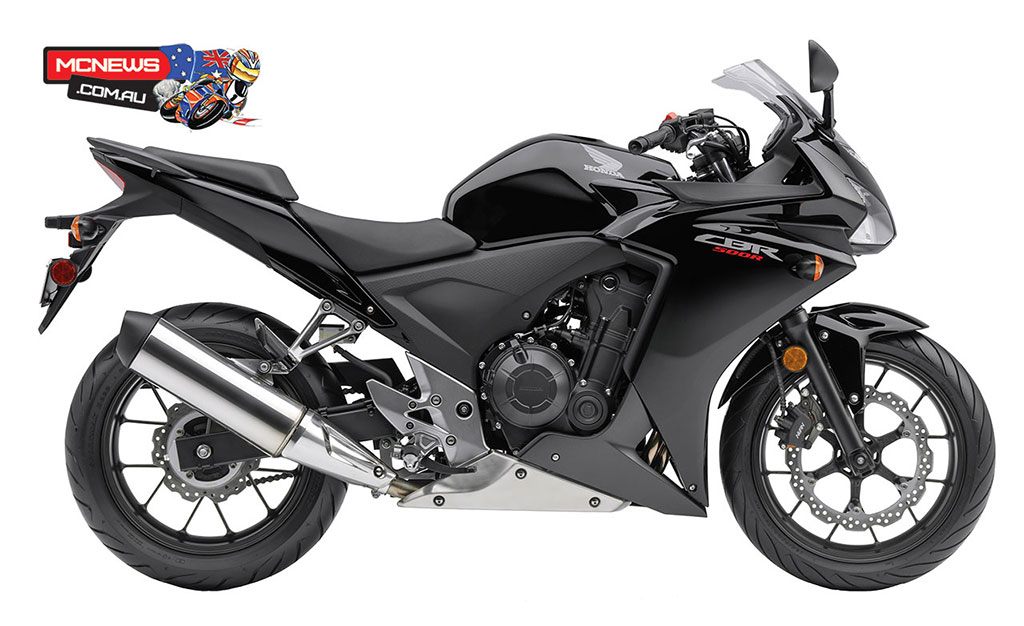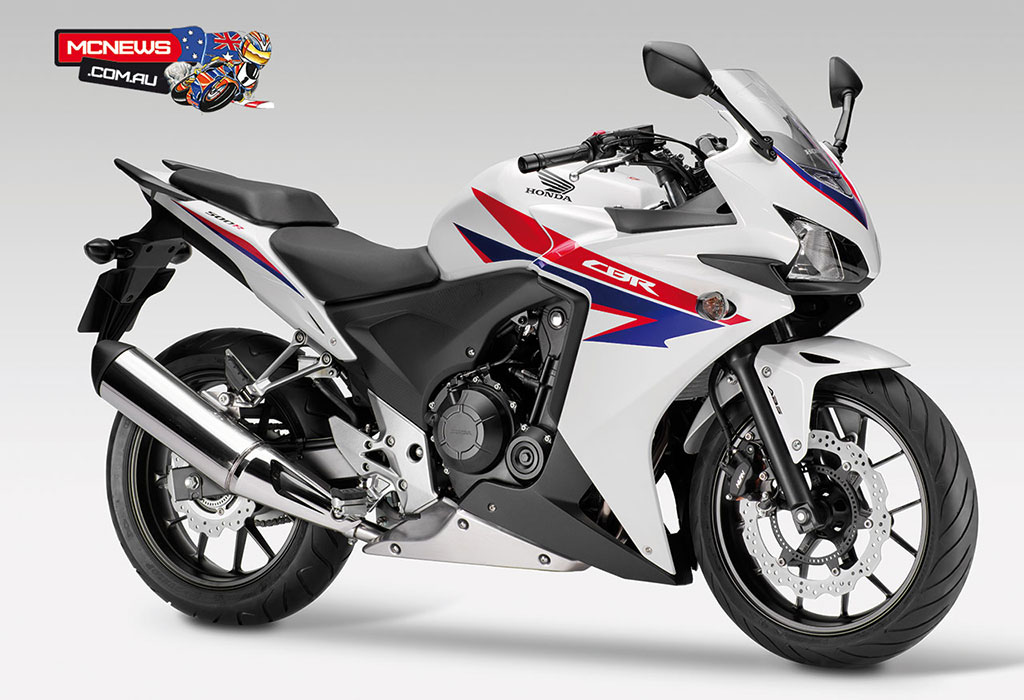The arrival of Honda’s CBR250R 18 months ago turned the learner bike market on its head. Smart, high-tech and at the bargain price of $5490, Honda came out hard to upset Kawasaki’s long running Ninja 250R party. And upset they did. Kawasaki was forced to drop their price by $1000 to compete with Honda but then returned fire with the much improved Ninja 300R to once again dominate the learner bike market, albeit at a slightly higher price than the Honda. KTM are now set to join that $7000 price point with their sexy new single-cylinder nakedbike, the 390 Duke, while Honda is setting the cat among the pigeons with the release of three new 500cc learner models priced from $6995. There clearly has never been a better time to be in the (long ignored) learner bike market. We recently threw a leg over the sportiest of Honda’s new 500cc models, the CBR500R, and came away quite impressed.
The learner market is overwhelmingly fashion conscious and the vast majority of learners want sporty, fully-faired bikes that look fast standing still. This is why Kawasaki’s racy looking Ninja 300 sells so well and it is a big part of the reason why Honda’s CBR500R will be a huge hit in the Australian market. It’s not quite as sharply styled as Team Green’s Ninja, as ever practical Honda dictated a slightly more upright and comfortable riding position to add more real world appeal to the CBR.
The scope of the styling is limited by the chassis it shares with two siblings, the CB500F (naked) and CB500X (adventure), both all new models that, alongside the CBR500R, form the backbone of Honda’s next generation basic motorcycle that ‘will deliver joy to our customers across the world’; this sounds a bit Japlish but gets the point across and brings home the new back to basics philosophy for Honda in their effort to grow and dominate the learner and emerging overseas markets with a slew of affordable, high quality models. This area of the market has long been short changed with unappealing, outdated machinery, but now thanks to the improving economies across Asia and fellow scooter/motorcycle mad countries like Brazil emerging as economic powerhouses, Australian learner motorcyclists are also winning thanks to companies now investing in this more budget friendly end of the market.
CBR500R colour schemes, lights and styling traits do portray a family resemblance to Honda’s Fireblade hero bike, and the CBR500R is a nice looking machine. Appearing much nicer in the flesh than photographs manage to convey. The hollow Y-spoke rims are a styling highlight while the low-rent looking swingarm is the low point. Overall though it is a sharp, modern looking machine and it would have to be a real style over substance decision by a true fashion conscious punter that would overlook the extra 200cc capacity advantage the Honda enjoys over the Kawasaki.
Despite the family resemblance to the aeons old CB500 motor, the CBR500R’s 471cc engine is no hand-me-down old-tech rattler. It is a thoroughly modern all-new lightweight 500cc parallel twin with a 180-degree crank and balancer shaft to keep things smooth. Compact roller rockers keep the heads slim and shims only require inspecting at the first service then every 24,000km, helping to keep servicing costs manageable. Two throttle bodies cast into a cleverly designed single housing incorporating a throttle position sensor, MAP sensor and IAT sensor all in the one unit further help simplify servicing. The engine is clearly under-stressed and has been designed with the 35kW (47hp) limit imposed on learners in many European countries rather than the more sensible power to weight ratios enforced under our own LAMS scheme. Australian delivered machines gain a modest boost to 37kw (50hp) to further extend the advantage the Honda enjoys over comparable machines.
The now familiar triangular layout of the crankcases seen on the CBR600RR and CBR1000RR are also evident in the design of the CBR500R engine while the twin cam covers lend the engine more aesthetic appeal in the naked CB variants that share this motor. Surprisingly, the pistons in the CBR500R are shared with the CBR600R thanks to big brother’s identical 67mm bore, some of the shifting mechanisms are also borrowed from the CBR600RR.
The CBR500R jumps off the line reasonably briskly and shuffling through the six-speed gearbox is no chore. 100km/h comes up quick enough and the machine is pretty much vibe free unless you start cruising at 120km/h or more. The machine has enough power in reserve for highway overtaking and is good for an indicated 170km/h. Its bottom end punch surprised quite a few of the assembled testers and a bit of one-wheel action with a spirited dump of the clutch and pull on the bars is not that hard to manage. The engine is surprisingly torquey and is happy to labour in a higher gear if you can’t be bothered making a downshift.
The backbone of the machine is a 35mm steel diamond-tube frame with detachable sub-frame and the engine acts as a stressed member of the chassis via four mounting points. Pro Link rear suspension is utilised at the rear and is adjustable for preload only while conventional 41mm forks deal with the bumps up front through 120mm of travel.
I can’t say we really tested the on-limit handling abilities of the CBR500R as the route was not conducive to such shenanigans but we did have enough of a crack to confirm that the machine holds no surprises and appears to have a thoroughly competent sweet-steering chassis with reasonable ground clearance. The 120/70-17 and 160/60-17 tyre sizes are sensible and the test machines were fitted with Dunlop Sportmax rubber. Wheelbase is 1410mm with the rake and trail set at 25.5-degrees and 102mm respectively.
Tipping the scales at a surprisingly hefty 192kg the CBR500R carries a significant 20kg more than the admittedly much less powerful Kawasaki Ninja 300R. While the Honda hides its bulk well there is no doubt it feels heavier than the Kawasaki. Let alone KTM’s new 390 Duke which is 40kg lighter than the CBR500R, while also enjoying a power advantage over the Kawasaki, the 375cc single-cylinder KTM however still can’t match the larger engined Honda for power and torque.
Braking performance is quite impressive but requires a firm pull on the lever for maximum retardation which will help prevent learners from locking the front wheel in slippery conditions when they grab a fist full in a panic. ABS is a $500 option on the CBR500R. I am not one to be a safety nanny but personally I would have liked to have seen Honda Australia make ABS standard, as Honda UK have done. ABS has come so far in the last couple of years that it offers better stopping in all conditions for highly experienced riders, let alone novices.
A low 790mm seat height and friendly ergonomics make the CBR500R’s perch a friendly place to spend time. A few of the assembled journos did complain of numb bum syndrome after 150km or so but the largely straight and unchallenging test route at the North Queensland launch would be partly to blame for their discomfort I suggest. Overall I found the ergonomics quite reasonable and the comfort levels agreeable. Pillion provisions are quite reasonable with a handy grab-rail, which for the fashion conscious soloists can be removed and replaced with an attractive and affordable rear seat cowl for $182. A larger screen comes in at $144.
Instrumentation is comprehensive with a fully electronic display incorporating a bar style tachometer red-lined at 8500rpm. A clear digital speedometer is located centrally alongside the time and odometer display. A segmented fuel gauge lets you know how much fuel is remaining in the generous 15.7 litre tank. With fuel economy on the official measures coming in at under 4 litres per 100km you won’t have to visit a service station too often, thanks to a 400km range. The only thing missing from the instrumentation is a gear position indicator, something that the target market for this bike might have found quite handy.
A tasteful white-dominant tri-colour scheme is perhaps the most attractive colour option for the CBR500R, with a solid red or solid black the remaining two options.
Is it the best option in the learner market we have ridden?
As an overall package, I would have to say yes.
The CBR500R is very competitive from a price point, marries great practicality with class leading performance and promises low running costs. It certainly mounts a convincing argument in its favour.
- Honda CBR500R Specifications
- Engine – 471cc liquid-cooled parallel twin, DOHC, 8-valve
- Bore x Stroke – 67 x 66.8mm
- Compression Ratio – 10.7:1
- Claimed Power – 50hp (37kW) at 8500rpm
- Claimed Torque – 43Nm at 7000rpm
- Induction – PGM FI
- Gearbox – Six speed
- L x W x H – 2075 x 740 x 1145mm
- Wheelbase – 1410mm
- Rake / Trail – 25.5 degrees / 102mm
- Seat Height – 790mm
- Ground Clearance – 140mm
- Fuel Capacity – 15.7 litres
- Tyres – 120/70-17 (F) 160/60-17 (R)
- Front Suspension – Conventional fork, 41mm
- Rear Suspension – Pro Link, nine stage adjustable preload
- Front Brake – Single 320mm disc, twin-piston caliper
- Rear Brake – 240mm disc
- Kerb weight – 192kg (194kg for ABS model)
- Warranty – Two Years
- RRP – $6995 ($7495 for ABS model)


















































